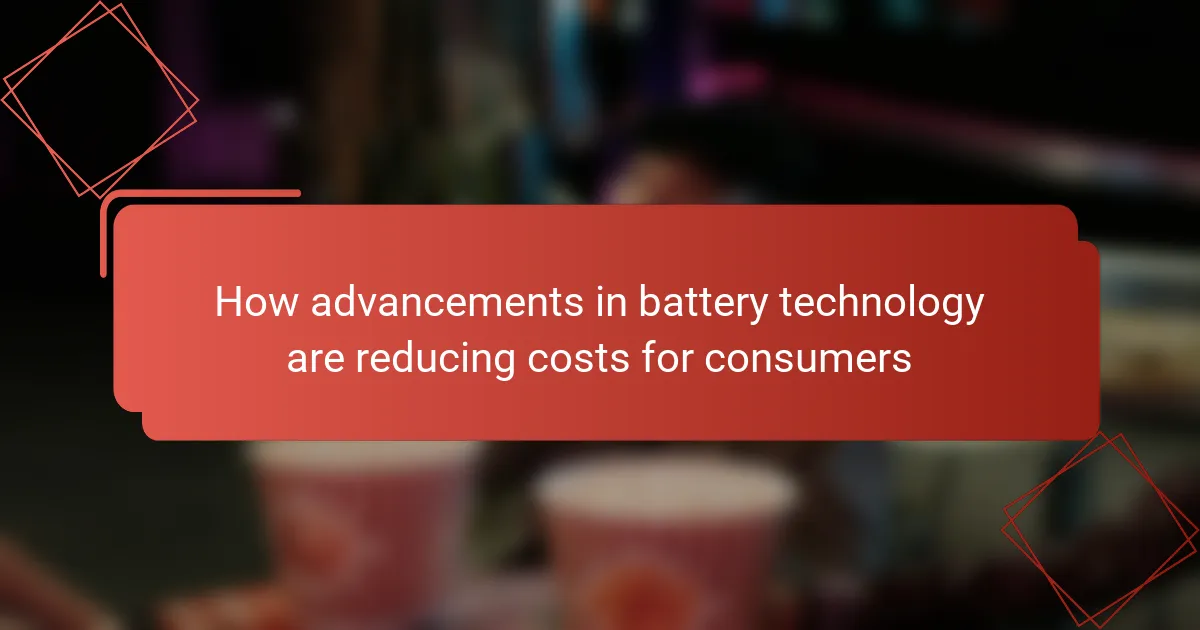Recent advancements in battery technology are driving down costs for consumers by improving efficiency, lifespan, and manufacturing processes. Innovations such as enhanced lithium-ion batteries and the emergence of solid-state batteries are making products more affordable across various industries, including electronics and electric vehicles.
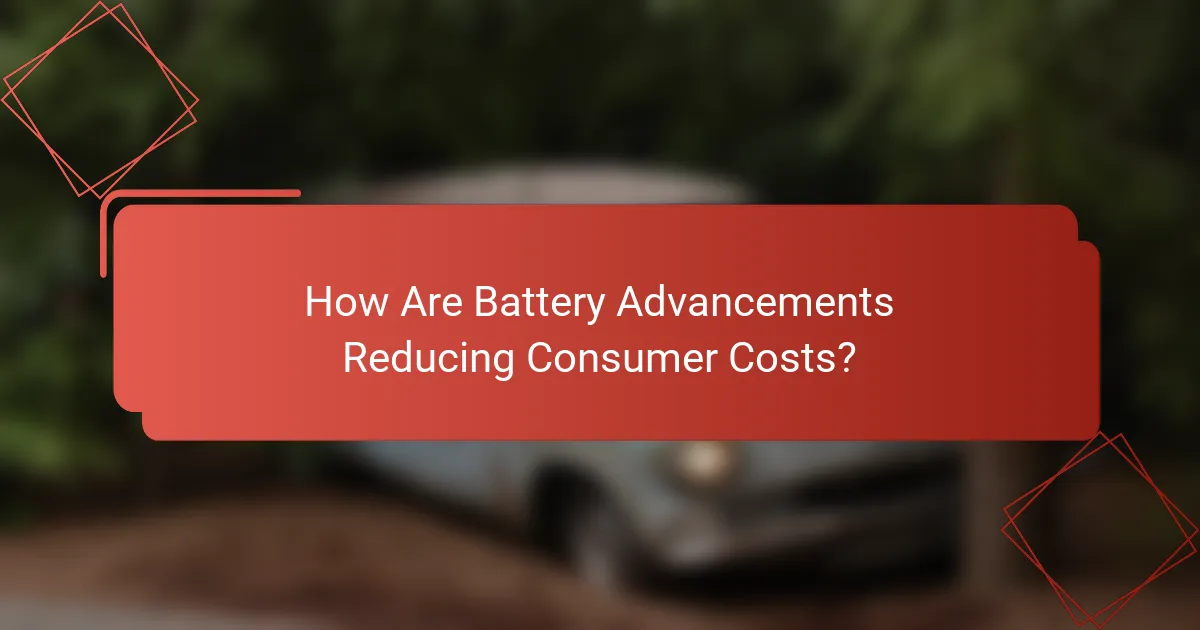
How Are Battery Advancements Reducing Consumer Costs?
Advancements in battery technology are significantly lowering costs for consumers by enhancing performance and efficiency. These improvements lead to longer-lasting, more affordable products across various sectors, including electronics and electric vehicles.
Increased energy density
Increased energy density means batteries can store more energy in a smaller space, which translates to longer usage times for devices. For example, modern lithium-ion batteries can offer energy densities exceeding 250 Wh/kg, allowing smartphones and laptops to run longer without needing a recharge.
This higher energy density reduces the need for frequent battery replacements, saving consumers money over time. As manufacturers adopt these advanced batteries, the overall cost of ownership for devices continues to decline.
Longer lifespan of batteries
Longer battery lifespans directly reduce costs for consumers by minimizing the frequency of replacements. Many new batteries can last several years or even up to a decade, depending on usage and technology.
For instance, electric vehicle batteries are now designed to maintain 70-80% of their capacity after 8-10 years, which means less financial burden on consumers who would otherwise need to invest in new batteries sooner.
Lower manufacturing costs
Lower manufacturing costs for batteries are achieved through improved production techniques and economies of scale. As technologies evolve, manufacturers can produce batteries more efficiently, reducing the overall cost per unit.
These savings are often passed on to consumers, resulting in lower prices for electronic devices and electric vehicles. For example, the cost of lithium-ion batteries has dropped significantly, from over $1,000 per kWh a decade ago to around $100 per kWh today.
Improved recycling processes
Improved recycling processes for batteries help reduce costs by recovering valuable materials that can be reused in new batteries. Enhanced recycling techniques can reclaim up to 95% of lithium, cobalt, and nickel, which lowers the demand for new raw materials.
As recycling becomes more efficient and widespread, consumers benefit from reduced prices for batteries and devices, as the supply chain becomes more sustainable and cost-effective. This also aligns with growing environmental regulations aimed at reducing waste and promoting circular economies.
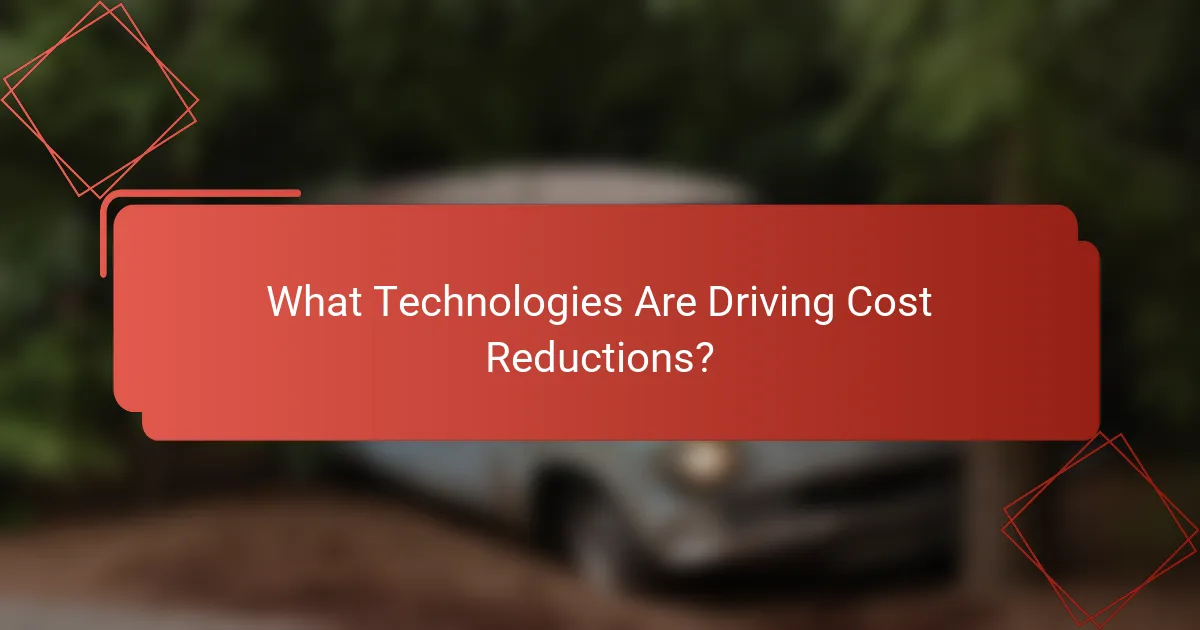
What Technologies Are Driving Cost Reductions?
Advancements in battery technology are significantly lowering costs for consumers by enhancing efficiency, lifespan, and production processes. Key innovations include improvements in lithium-ion batteries, the development of solid-state batteries, and the implementation of advanced battery management systems.
Lithium-ion battery improvements
Recent enhancements in lithium-ion battery technology focus on increasing energy density and reducing manufacturing costs. Innovations such as silicon anodes and improved electrolyte formulations can boost performance while lowering expenses, making these batteries more affordable for consumers.
For example, the shift from traditional graphite anodes to silicon-based alternatives can increase energy capacity by up to 50%, leading to longer-lasting devices without a significant price increase. This transition is crucial for electric vehicles and portable electronics, where battery performance is critical.
Solid-state battery innovations
Solid-state batteries represent a transformative shift in energy storage, utilizing solid electrolytes instead of liquid ones. This change enhances safety and energy density, which can lead to lower costs over time as production scales up.
While still in the development phase, solid-state batteries could reduce costs by minimizing the risk of overheating and extending battery life. As manufacturers refine production techniques, consumers may see more affordable options in the market within the next few years.
Battery management systems
Advanced battery management systems (BMS) play a critical role in optimizing battery performance and longevity. These systems monitor various parameters, including temperature, charge cycles, and health status, ensuring that batteries operate efficiently and safely.
By improving the lifespan and reliability of batteries, BMS can help reduce overall costs for consumers. For instance, effective management can extend battery life by 20-30%, minimizing the need for replacements and enhancing the value of devices and electric vehicles.
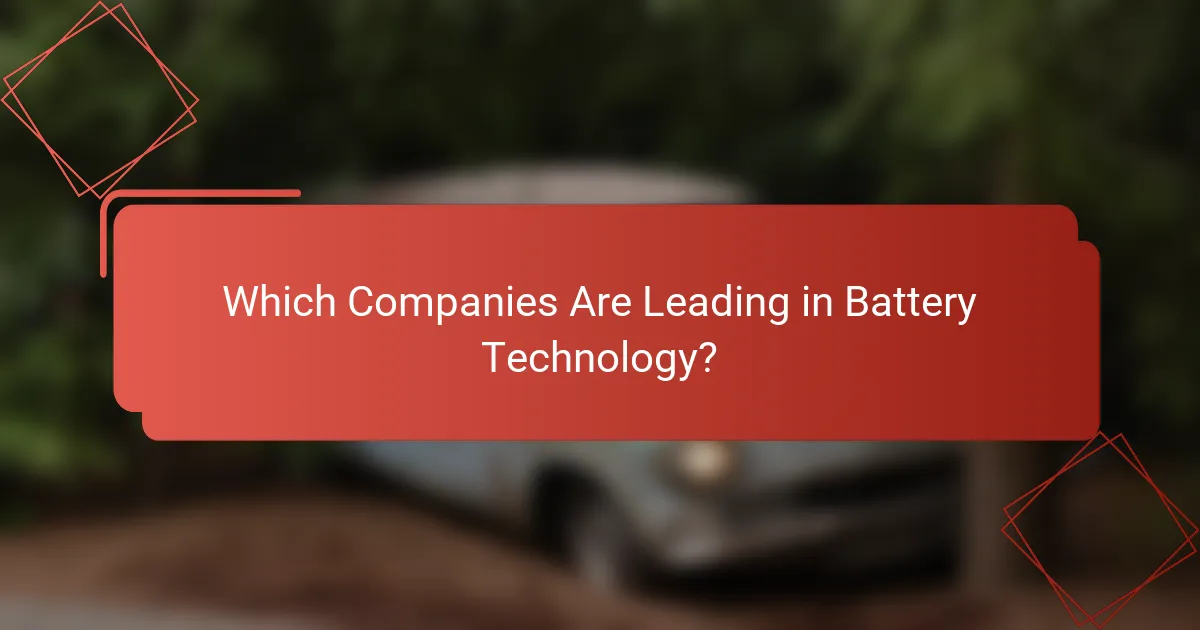
Which Companies Are Leading in Battery Technology?
Several companies are at the forefront of battery technology, significantly impacting costs for consumers. Tesla, Panasonic, and CATL are notable leaders, each contributing unique advancements that enhance efficiency and affordability in battery production.
Tesla’s battery advancements
Tesla has made significant strides in battery technology, particularly with its development of the 4680 battery cell. This new design aims to reduce production costs by simplifying manufacturing processes and increasing energy density. As a result, consumers can expect lower prices for electric vehicles (EVs) and energy storage solutions.
Additionally, Tesla’s Gigafactories are designed to scale production rapidly, which helps drive down costs further. By producing batteries in-house, Tesla can maintain better control over quality and pricing, ultimately benefiting consumers with more affordable options.
Panasonic’s cost-effective solutions
Panasonic has focused on creating cost-effective battery solutions, particularly for electric vehicles. Their partnership with Tesla has led to improvements in battery chemistry and manufacturing efficiency, which help lower costs. Panasonic’s advancements in lithium-ion technology also contribute to longer-lasting batteries, providing better value for consumers.
Moreover, Panasonic is investing in new production facilities to increase capacity and reduce costs. This commitment to innovation ensures that consumers will have access to more affordable and efficient battery options in the near future.
CATL’s innovations in battery production
CATL, a leading Chinese battery manufacturer, is known for its innovative approaches to battery production. The company has developed new battery chemistries that enhance energy density while reducing costs. Their focus on research and development allows them to stay ahead in the competitive battery market.
In addition, CATL has implemented advanced manufacturing techniques that streamline production processes. This efficiency translates to lower prices for consumers, making electric vehicles and energy storage systems more accessible. CATL’s commitment to sustainability also ensures that their products meet growing environmental standards, appealing to eco-conscious consumers.
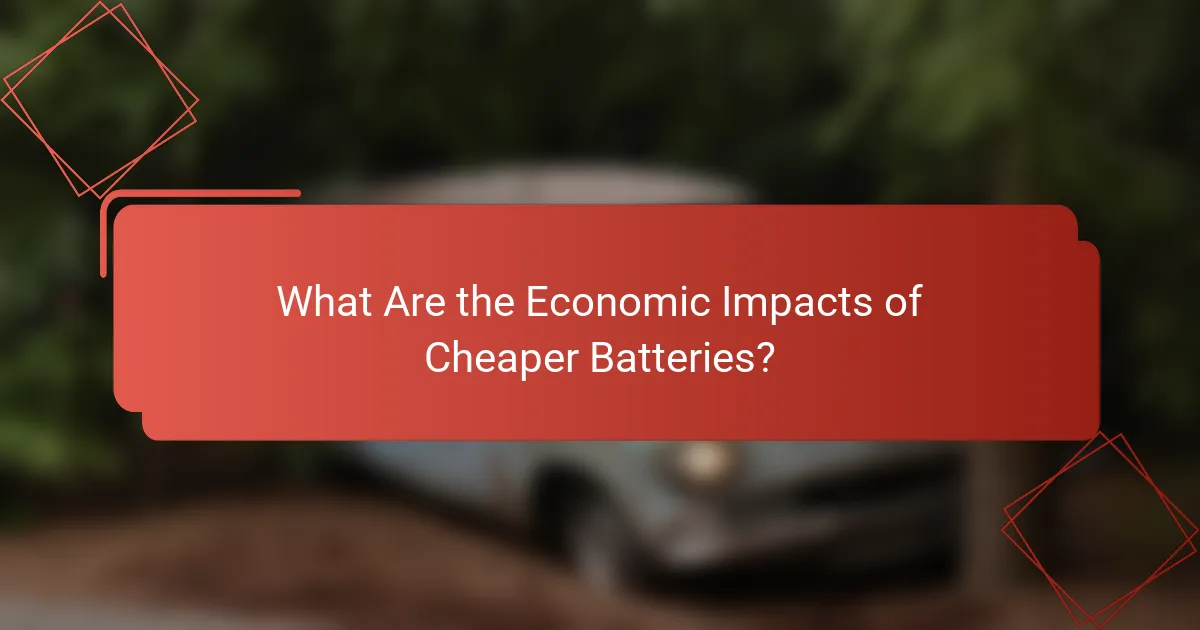
What Are the Economic Impacts of Cheaper Batteries?
Cheaper batteries significantly lower costs for consumers by making electric vehicles and renewable energy sources more accessible. As battery technology advances, these reductions lead to broader economic benefits, including decreased energy expenses and increased adoption of sustainable practices.
Lower prices for electric vehicles
The reduction in battery costs directly influences the pricing of electric vehicles (EVs). As manufacturers save on battery production, these savings can be passed on to consumers, making EVs more affordable and competitive with traditional gasoline vehicles.
For example, the average price of an electric vehicle has seen a decline of several thousand dollars over recent years, largely due to advancements in battery technology. This trend encourages more consumers to consider EVs, contributing to a shift in the automotive market.
Reduced energy costs for consumers
Cheaper batteries enable more efficient energy storage solutions, which can lower energy bills for households. With improved battery technology, consumers can store energy generated from renewable sources, like solar panels, and use it during peak hours when electricity prices are higher.
By investing in home battery systems, consumers can save on energy costs by utilizing stored energy instead of purchasing it from the grid. This can lead to savings of up to 30% on monthly electricity bills, depending on usage patterns and local energy prices.
Increased adoption of renewable energy
The affordability of batteries supports the growth of renewable energy by making it easier to store and manage energy from sources like wind and solar. As battery prices decrease, more individuals and businesses are likely to invest in renewable energy systems, knowing they can effectively store excess energy for later use.
Government incentives and subsidies further encourage this shift, with many regions offering financial assistance for solar panel installations paired with battery storage. This combination not only reduces reliance on fossil fuels but also promotes a more sustainable energy future.
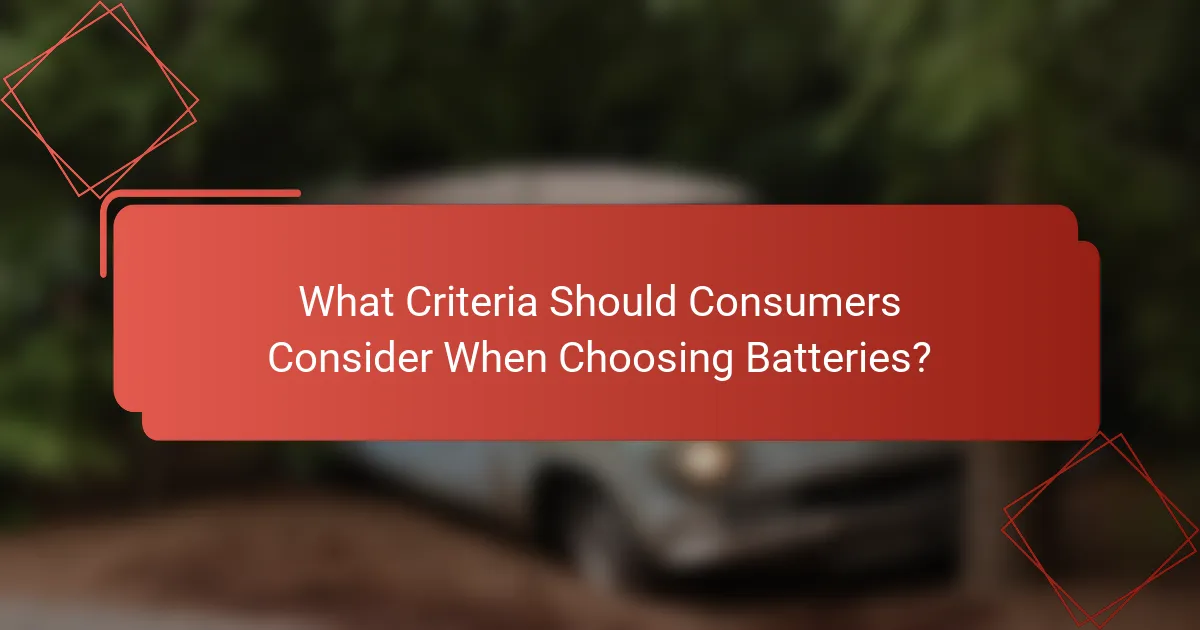
What Criteria Should Consumers Consider When Choosing Batteries?
When selecting batteries, consumers should focus on battery capacity, charging speed, and warranty and lifespan. These factors significantly influence performance, usability, and long-term value.
Battery capacity
Battery capacity, measured in milliampere-hours (mAh) or watt-hours (Wh), indicates how much energy a battery can store. Higher capacity generally means longer usage times between charges, making it crucial for devices that require extended operation, such as smartphones or electric vehicles.
For example, a smartphone battery with a capacity of 4000 mAh can typically last a full day under moderate usage. In contrast, a battery with 2000 mAh may require more frequent charging, which can be inconvenient.
Charging speed
Charging speed refers to how quickly a battery can be recharged, often measured in hours or minutes. Fast charging technologies can significantly reduce downtime, allowing consumers to quickly power up their devices.
For instance, many modern smartphones support fast charging, enabling a full charge in under an hour. However, it’s essential to use compatible chargers, as using the wrong one can damage the battery or reduce its lifespan.
Warranty and lifespan
The warranty and lifespan of a battery are critical for assessing its long-term value. A longer warranty often indicates manufacturer confidence in the product’s durability, while lifespan refers to how many charge cycles a battery can undergo before its capacity significantly diminishes.
Typically, lithium-ion batteries last between 2 to 5 years, depending on usage and care. Consumers should look for warranties that cover at least two years, as this can provide peace of mind and protection against early failures.
